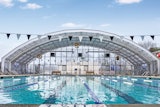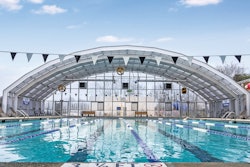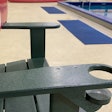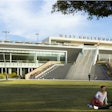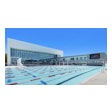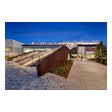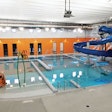A number of design schemes and alternative-energy strategies can help operators beat the price of natural gas.
Given the increasing cost of energy, selection of equipment and systems that provide good operating cost efficiency can be extremely important to the long-term viability of any commercial aquatic facility.
Identifying the scope of the problem facing facility operators is useful when discussing the issue of energy efficiency. In just the past few years in the bellwether state of California, the cost of natural gas has risen from a statewide average of $0.55 per therm to almost $0.85 per therm, and the cost of electricity has jumped from $0.10 per kilowatt hour to nearly $0.15 per kilowatt hour.
Annual operating costs for a typical outdoor 25-yard-by-50-meter pool in today's dollars run about $256,000, and break down as follows:
Natural gas - 72 percent ($184,400)
Electricity - 16 percent ($40,800)
Pool chemicals - 8 percent ($20,900)
Water usage - 4 percent ($9,400)
These figures translate into an operating cost increase for natural gas and electricity of more than $75,000 annually within a relatively short time frame. Given this less-than-pleasant reality, what can you do when planning a new facility, or renovating an existing one, to ensure that you are not driving the aquatic-facility equivalent of a Hummer?
The good news is that there are a number of basic, energy-efficient design strategies that can be employed including:
High-efficiency pumps. At times, consultants and contractors select swimming pool pumps based on their initial cost and availability. For example, a relatively inexpensive, readily available self-priming pump may operate at 55 to 60 percent motor efficiency. This is due to the fact that the pump motor spins at 3,450 revolutions per minute. One of the goals of energy-efficient design is to select pumps with a minimum 75 percent motor efficiency. Pumps with these types of motor efficiencies will cost more initially, and require installation at an elevation below the static water level of the pool being served. However, if a lower-rpm pump motor (in the range of 1,150 to 1,750 rpm) is selected, one can achieve up to 85 percent motor efficiency.
In nearly every case, the careful selection of pumps can provide significant operational cost savings. (It was estimated recently that one project owner would save approximately $22,000 per year in electricity costs by specifying lower-rpm motors.) An additional benefit to specifying lower-rpm pumps is that the longevity of the motors is at least twice that of their harder-working counterparts.
Variable-frequency drives. In addition to selecting more-efficient pumps, the use of variable-frequency drives can provide significant reductions in electrical energy use associated with electric motors operating over extended periods of time. For example, in many jurisdictions, state and local health departments mandate the sizing of pool circulation pumps for the worst possible condition (that is, a dirty filter and a pump strainer full of debris). What this means in practical terms is that when conditions are optimal, the circulation pump is oversized for the actual design condition. In some cases, health regulations mandate sizing of a 20-horsepower pump when the actual design condition for 95 percent of the operating hours would only require a 15-horsepower pump.
By connecting a VFD package to the pump motor and providing a highly accurate digital flow meter with input back to the VFD, the operator can set the flow rate required by the health department, and the VFD controls the voltage to the pump motor based on the actual design condition. If the filter is clean and the pump strainer empty, the pump motor does not have to work as hard to deliver the required flow rate. Similar to a dimmer switch, the VFD can "dial" the horsepower output up and down as required to meet actual conditions, which results in considerably higher motor efficiencies. VFD packages for pump motors in the 10- to 20-horsepower range run approximately $3,000 to $5,000 (depending on motor size), and many operators have reported 30 to 50 percent electricity cost savings as a result.
Automated filtration systems. Every time a filtration system backwashes, money is lost not only in the water that goes down the drain, but in the cost to heat and chemically treat that same lost water. Many filtration systems incorporate manual backwash, in which the operator backwashes the filtration system on a regular maintenance schedule whether the system needs backwashing or not. Filtration systems utilizing microprocessor control backwash based on pressure differential, meaning only when the system measures an influent (water within the filtration system) pressure higher than a preset limit. Rather than backwashing once a week (whether the system needs it or not), automation allows the system to backwash only when necessary, thereby saving water, heating and chemical treatment costs.
High-efficiency pool heaters. Pool heaters, while similar to traditional water-heating boilers, have historically been less than stellar when it comes to energy efficiency. However, since pool water is heated directly within the heaters, they are capable of being more efficient than traditional plate-and-frame or tube-and-shell heat exchangers connected to a central boiler plant. Within recent years, pool heater manufacturers have greatly improved the efficiencies of their products. Pool heaters that are up to 89 percent thermal efficient are now commonly available.
Thermal blankets. While operators may complain about the labor that it takes to remove and replace pool covers each day, you save more money utilizing a well-insulated set of thermal blankets on your pool - even indoors - than just about anything else. Studies of outdoor pools have shown up to a 40 percent savings in natural gas costs for those operators who are dutiful in replacing the pool blankets every evening. At an average capital cost of $2.50 per square foot of water surface area, thermal blankets can pay for themselves in six to 12 months.
While just beginning to see widespread use, the above design strategies only skim the surface of available energy savings. Several alternative energy sources can also be employed to operate pools at their highest efficiency possible. These include:
Passive thermal solar systems. Passive thermal solar systems produce no air emissions, and installations typically utilize the existing pool circulation pump to discharge water through a series of solar collectors, where a transfer of heat from the sun to the pool water occurs. Downstream of the pool filtration system (but upstream of the pool heater), a bypass piping system is installed to route the pool water into the solar collectors. Since the pool heater is activated by low pool water temperature, if the solar system can provide the necessary set-point water temperature, the pool heater is not activated, thereby reducing the run time for the pool heater, and the associated cost for natural gas.
Over the past decade, there has been a great deal of interest in solar heating expressed by commercial pool operators. With utility rates spiking more recently, this interest has reached a fever pitch. When natural gas had a unit price of $0.55 per therm, proposing solar was an exercise in political correctness, since the payback averaged eight to 10 years, and the average life of most systems is 12 years. However, with natural gas prices hovering in the vicinity of $0.85 per therm, full return on investment is in the four-to-six-year range, which is considerably more attractive to the average pool operator.
Generally speaking, copper and glazed solar panels are the most efficient (and expensive) of the systems available. However, these are less than ideal for commercial aquatic facilities because of the potential for vandalism (kids love to toss rocks at and break the glazed panels). In addition, the high potential for out-of-balance water chemistry within pool water can wreak havoc within the copper piping. For example, if the pH feed system were to malfunction and drive the pH down below 7.0, copper could precipitate out of the solar heating system and into the pool water, discoloring the pool plaster to the point where it might have to be completely replaced.
For these reasons, the use of non-metallic solar panels (typically polypropylene or EPDM collectors) is preferred. Installed costs for this type of passive solar system (assuming suitable mounting space with proper solar orientation is available) run approximately $12 to $18 per square foot of solar panel. The amount of solar panels required varies greatly by region, but an average of 80 percent of water surface area is common for all but the most sunlight-challenged spots within North America. For an outdoor 25-yard-by-50-meter pool, this translates into a requirement of approximately 10,000 square feet of solar panels, with installed costs ranging from $120,000 to $180,000. However, with a potential annual operating cost savings of $50,000 to $75,000, passive solar can be an attractive option for many pool operators.
Microturbine cogeneration. The term "cogeneration" implies multiple sources of energy from a single device. For gas-powered microturbines, both electricity and heat (which can be recovered) are produced. This technology has its roots in the aircraft industry - specifically, auxiliary-power turbines. Simple devices with few moving parts, microturbines burn fuel (in this case natural gas) within a combustion chamber, and expanding exhaust gases spin a high-speed turbine, the shaft of which is connected to a generator that produces electricity. The heat generated during combustion is recovered by means of a heat exchanger, through which pool water is circulated, resulting in a preheating of pool water before it passes through a traditional pool heater.
Gas-powered microturbines range in size from 25 kW to 500 kW, and are typically sized based on anticipated electrical demand, since these units produce substantially greater electricity than heat that can be recovered. The primary reason for sizing for electrical demand is that net-metering (where excess electrical power generated is sold back to the local utility) is usually not feasible unless a renewable-energy source such as landfill or biogas is utilized. Where heat recovery is incorporated into the system design, these systems can be up to 85 percent efficient, with cost to produce electricity ranging from $0.005 to $0.016 per kW, and maintenance intervals of 5,000 to 8,000 hours.
Additional benefits associated with these systems are the relatively low NOx emissions (from less than 9 ppm to around 50 ppm) and the possibility of incentive program rebates from local utility providers for installation of self-generating power systems. One drawback of microturbines is that they can be quite loud - imagine a jet taking off - and should be installed within an acoustically engineered enclosure or building.
Capital costs for microturbines vary depending on size and whether the heat-recovery option is supplied. A popular 60 kW unit with heat recovery costs approximately $100,000 installed, and recent case studies are promising, with payback within 2.5 to 3.5 years.
Fuel-cell cogeneration. Cogeneration utilizing fuel-cell technology is similar in process to gas-powered microturbines in that electricity is generated and heat is recovered. A fuel cell generates electricity by combining hydrogen and oxygen in an electrochemical reaction that produces direct current (DC) power, water vapor and waste heat. These systems utilize natural gas as the fuel source, which is reformed by the system into a steady stream of input hydrogen. Because of the lack of conventional combustion, fuel cells are reliable, efficient, quiet and virtually pollution-free. Economic advantages of fuel-cell technology are heavily dependent on local utility rates and the availability of rebates and incentives to offset initial capital costs.
Cogeneration with fuel cells is an emerging technology with a small number of installations to date, and an approximate 10-year commercial track record. Since there are only two commercial manufacturers of fuel cells (UTC Fuel Cells, a subsidiary of United Technologies, and Fuel Cell Energy), capital costs remain high, in the range of $1.1 million to $1.2 million for systems of 200 to 250 kW power output. Payback for these systems ranges from 8 to 12 years.
Photovoltaic electricity generation systems. Not to be confused with passive thermal solar systems, photovoltaic systems convert sunlight into electricity, but unlike cogeneration systems, no heat is generated in the process. PV systems are simple, reliable, produce no noise or pollution, and have no moving parts. Initial capital costs are high, at an average of $7 to $10 per watt for standard flat-mounted roof systems, which can add up to $250,000 for a 50 kW photovoltaic system. This cost assumes rebates and incentives from local utilities. Historically, payback on PV systems can be as long as 40 years.
Utility costs will continue to fluctuate, which will require either scaled-back operations or adoption of some of these strategies to reduce the bottom-line impact. Because of an increased awareness on the part of most facility owners, consultants and contractors are slowly incorporating more energy-efficient strategies into their designs and installations. At a minimum, pool operators need to become more familiar with these technologies and recognize that while maximizing energy efficiency is not cheap or free, it can provide a worthwhile return on investment.









